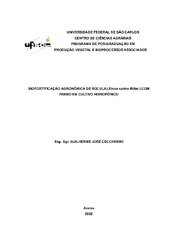| dc.contributor.author | Ceccherini, Guilherme José | |
| dc.date.accessioned | 2022-08-02T13:42:16Z | eng |
| dc.date.available | 2022-08-02T13:42:16Z | eng |
| dc.date.issued | 2022-05-27 | eng |
| dc.identifier.citation | CECCHERINI, Guilherme José. Biofortificação agronômica de rúcula (Eruca sativa Miller.) com ferro em cultivo hidropônico. 2022. Dissertação (Mestrado em Produção Vegetal e Bioprocessos Associados) – Universidade Federal de São Carlos, Araras, 2022. Disponível em: https://repositorio.ufscar.br/handle/ufscar/16447. | * |
| dc.identifier.uri | https://repositorio.ufscar.br/handle/ufscar/16447 | por |
| dc.description.abstract | Arugula is the second most cultivated leafy vegetable in the NFT (Nutrient Film
Technique) hydroponic system, as it guarantees greater productivity, shorter
cultivation cycle and greater efficiency in the use of water and fertilizers.
Biofortification is a technique that aims to enrich the edible parts of agricultural
products with micronutrients in the parts used for plant consumption. Biofortification,
for example, with iron is a way to minimize anemia. The objective of this research
was to evaluate the effect of iron doses on the biofortification of two arugula varieties
in a hydroponic system, in the winter and summer period. The experimental design
was in randomized blocks, with a factorial of 4 doses of chelated iron (EDDHA)
(T1=1.8; T2=3.6; T3=5.4 and T4=7.2 g 1000L-1
) x 2 arugula cultivars (V1= Astro and
V2= Roka), with four replications. Agronomic evaluations of plant diameter, number
of leaves, plant height, root length, root and shoot fresh mass, root and shoot dry
mass, productivity and iron accumulation in shoots and roots were carried out, in
addition to instrumental analysis of leaf area, total chlorophyll index and colorimetric
analysis. Only the fresh root mass was equal to the statistics performed. Iron
accumulation in roots was considerably higher than in leaf tissue, about 10-20 times
higher. Therefore, in the winter period, Astro at the dose of 3.6 mg 1,000L-1 and
Roka, in the summer period of the treatment, 7.2 mg 1,000L-1
, were the ones that
showed the highest translocation and accumulation of Fe in the edible part. | eng |
| dc.description.sponsorship | Não recebi financiamento | por |
| dc.language.iso | por | por |
| dc.publisher | Universidade Federal de São Carlos | por |
| dc.rights | Attribution-NonCommercial-NoDerivs 3.0 Brazil | * |
| dc.rights.uri | http://creativecommons.org/licenses/by-nc-nd/3.0/br/ | * |
| dc.subject | Enriquecimento | por |
| dc.subject | EDDHA | por |
| dc.subject | NFT | por |
| dc.subject | Hidroponia | por |
| dc.subject | Verão | por |
| dc.subject | Enrichment | eng |
| dc.subject | Hydroponics | eng |
| dc.subject | Summer | eng |
| dc.title | Biofortificação agronômica de rúcula (Eruca sativa Miller.) com ferro em cultivo hidropônico | por |
| dc.title.alternative | Agronomic biofortification of arugula (Eruca sativa Miller.) with iron in hydroponic cultivation | eng |
| dc.type | Dissertação | por |
| dc.contributor.advisor1 | Sala, Fernando César | |
| dc.contributor.advisor1Lattes | http://lattes.cnpq.br/6771975466075202 | por |
| dc.description.resumo | A rúcula é a segunda hortaliça folhosa mais cultivada no sistema hidropônico NFT
(Nutrient Film Technique), pois garante maior produtividade, menor ciclo de cultivo e
maior eficiência no uso da água e dos fertilizantes. Biofortificação é uma técnica que
visa enriquecer as partes comestíveis de produtos agrícolas com micronutrientes nas
partes utilizadas para consumo das plantas. A biofortificação, por exemplo, com ferro
é uma forma de minimizar a anemia. O objetivo desta pesquisa foi avaliar o efeito
das doses de ferro na biofortificação de duas variedades de rúcula em sistema
hidropônico, no período do inverno e verão. O delineamento experimental foi em
blocos casualizados, com fatorial de 4 doses de ferro quelatizado (EDDHA) (T1=1,8;
T2=3,6; T3=5,4 e T4=7,2 g 1000L-1
) x 2 cultivares de rúcula (V1= Astro e V2= Roka),
com quatro repetições. Foram realizadas as avaliações agronômicas de diâmetro da
planta, número de folhas, altura da planta, comprimento da raiz, massa fresca da
raiz e parte aérea, massa seca da raiz e parte aérea, produtividade e acúmulo de
ferro na parte aérea e raízes, além das análises instrumentais de área foliar, índice
de clorofila total e análise colorimétrica. Apenas a massa fresca de raiz apresentou
ser igual perante a estatística realizada. O acúmulo de ferro nas raízes foi
consideravelmente maior que no tecido foliar, superior em cerca de 10-20 vezes.
Assim sendo, no período do inverno a Astro na dose 3,6 mg 1.000L-1 e a Roka no
período do verão do tratamento 7,2 mg 1.000L-1, foram as que apresentaram maior
translocação e acúmulo de Fe na parte comestível. | por |
| dc.publisher.initials | UFSCar | por |
| dc.publisher.program | Programa de Pós-Graduação em Produção Vegetal e Bioprocessos Associados - PPGPVBA-Ar | por |
| dc.subject.cnpq | CIENCIAS AGRARIAS::AGRONOMIA::FITOTECNIA | por |
| dc.publisher.address | Câmpus Araras | por |
| dc.contributor.authorlattes | http://lattes.cnpq.br/0192036018907086 | por |


